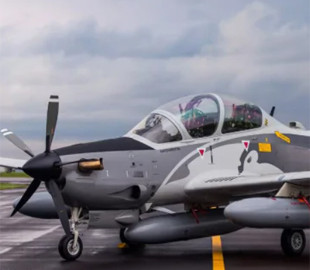
It is interesting that the A-29 Super Tucano — it is a turboprop aircraft that is younger than the F-15 and F-16 fighters. The machine, obviously, cannot stand up to modern models of combat aviation, but it was not created for this, but for close air support.
The US Air Force Test Pilot School at Edwards Air Force Base has added three Embraer aircraft to its fleet A-29 Super Tucano — these are the first new planes that the school received in almost 30 years.
Focus translated an article by American journalist Peter Suchiu about the role of A-29 Super Tucano aircraft in the US Air Force.
- A-29 aircraft, originally purchased by the Air Force Special Operations Command, but later retired , was saved from potential sale to foreign militaries and will now assist in training and research. The turboprop aircraft is equipped with modern avionics and is ideal for testing in corkscrew mode and carrying various sensors and weapons.
- Thanks to this replenishment, the training load on the T-38 and F-16 aircraft will decrease. The A-29 is also rumored to be able to replace the A-10 Thunderbolt II in close air support missions due to its long time in the air and multi-seat cockpit.
A-29 Super Tucano joins training fleet Air Force at Edwards Air Force Base
The U.S. Air Force Test Pilot School at Edwards Air Force Base, California, has received its first “new aircraft” in nearly three decades, the air service announced this week. But it is not about new modern fighters — instead, three Embraer A-29 Super Tucanos appeared in the school's fleet.
According to The War Zone, the A-29s arrived at Edwards Air Force Base in July, but just this week the 412th Test Wing (the unit to which the school of test pilots belongs) officially received them.
“The decision to deploy the A-29s to Edwards was the result of careful analysis by the Test Pilot School and an excellent example of command agility and cooperation in utilizing a unique, fast-moving capability,” explained Michael Banzet, director of plans and programs at the Test Center. Air Force — This is not only a $63 million taxpayer investment, but also a modernization and expansion of the School's training program to accelerate the combat capability of the US Air Force.”
Super economical close air support aircraft
The aircraft is much newer in design than the F-15 and F-16: although the A-29 Super Tucano is a turboprop, it was developed in the 1990s. It may not be able to withstand a modern fighter, but it was not created for this. It was most likely designed as a low-cost close air support (CAS) aircraft capable of operating from hard-to-reach airfields. For CAS missions, it is armed with twin 50-caliber machine guns on each wing, as well as five mounts for assault ammunition.
200% Deposit Bonus up to €3,000 180% First Deposit Bonus up to $20,000During its service with the Air Force around the world, including in South America and Asia, the Super Tucano has flown 60,000 combat hours, including operations to intercept drug trafficking.
Changing roles
According to the statement Air Force, three A-29 Super Tucanos “were originally purchased by the Air Force Special Operations Command, but were sold after operational requirements changed.” Acquired by the Special Operations Forces Command in 2017, the A-29 was considered for use in the Armed Overwatch program, but the command then preferred to use a paramilitary version of the AT-802 gunship.
When the A-29s were no longer needed by the Special Forces, the Air Force Test Center and the school's management did not forget the opportunity to retrieve the aircraft, which were stored at the Davis-Monthan Air Force Base in Arizona until they were sold abroad under the Foreign Military Sales (FMS) program.< /p>
Instead of going to US partners, the Super Tucanos will now be used at the flight school to expand flight test and training capabilities. The A-29's airframe design lends itself well to corkscrew testing, and being a Cold War era aircraft, it is equipped with modern avionics and even has the ability to mount external equipment on wing hangers.
This last fact will enable the Air Force Academy -testers to conduct training and research of “various sensors and weapons”, and will also help reduce “dependence on T-38 and F-16 aircraft and expand the capabilities of performing individual test tasks entrusted to the Air Force test center”, — the department informed.
A-10 replacement
While the A-29 Super Tucano's role will most likely be limited to training, there are already calls to use it as a close air support aircraft in place of the venerable A-10 Thunderbolt II.
“The A-29 is a more than adequate candidate to replace the A-10,” writes Maya Carlin in an article for The National Interest. its primary application is low-intensity close air support and counterinsurgency. The A-29's air time combined with its multi-seat cockpit makes it an ideal platform for such missions.” Carlin adds: “What the longer the A-29 stays in position, the longer it can support ground forces and assets. Also, the importance of having two crews to maintain situational awareness in a dynamic close air support environment cannot be underestimated.”
About the author< /h2>
Peter Suchiu — journalist from Michigan. During his twenty-year journalistic career, he participated in the work of more than four dozen magazines, newspapers and websites, publishing more than 3,200 materials. He writes regularly on military technology, firearms history, cyber security, politics and international affairs. Peter has also contributed articles to Forbes and Clearance Jobs. You can follow him on Twitter: @PeterSuciu. Email the author at: Editor@nationalinterest.org.

